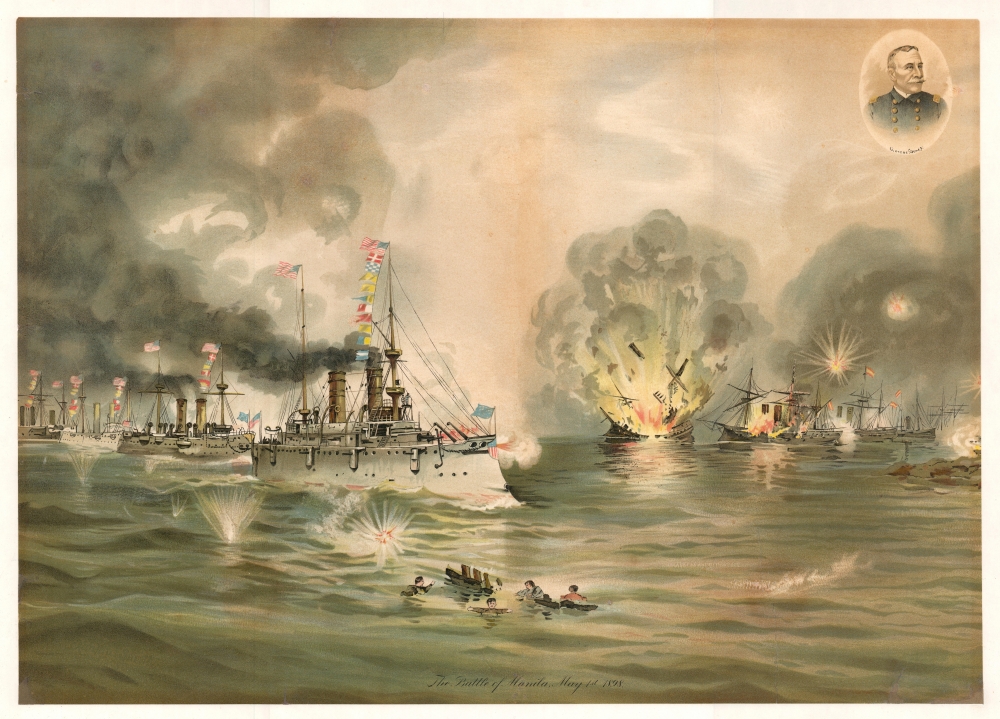1898 Xanthus Russell Smith View of the Battle of Manila, the Philippines
BattleofManila-xanthussmith-1898-2
Title
1898 (dated) 20 x 28 in (50.8 x 71.12 cm)
Description
The Battle of Manila
The American Asiatic Squadron under Commodore George Dewey engaged and destroyed the Spanish Pacific Squadron under Admiral Patricio Montojo. At 5:41 AM, with the now famous command, 'You may fire when ready, Mr. Gridley,' Commodore Dewey instructed Olympia's Captain to begin the bombardment of the Spanish fleet. After a furious exchange of fire, Captain Gridley messaged Dewey that only 15 rounds of ammunition remained per gun. Concerned, Dewey ordered an immediate withdraw. So as not to alarm the crew, he announced that they were 'pausing for breakfast' - which they proceeded to enjoy. During this historic 'breakfast' it became apparent that the communication has gone awry and that the actual message was that Gridley has 'expended only 15 rounds of ammunition per gun.' The Battle commenced at 10:40 AM and followed with the surrender and total destruction of the Spanish squadron. The Spanish colors were struck at 12:40 PM.Chromolithography
Chromolithography, sometimes called oleography, is a color lithographic technique developed in the mid-19th century. The process involved using multiple lithographic stones, one for each color, to yield a rich composite effect. Oftentimes, the process would start with a black basecoat upon which subsequent colors were layered. Some chromolithographs used 30 or more separate lithographic stones to achieve the desired product. Chromolithograph color could also be effectively blended for even more dramatic results. The process became extremely popular in the late 19th and early 20th centuries, when it emerged as the dominant method of color printing. The vivid color chromolithography produced made it exceptionally effective for advertising and propaganda imagery.Publication History and Census
This view was painted by Xanthus Russell Smith in 1898, shortly after the battle itself. This chromolithograph view of the battle was printed by Joseph Hoover and Son. Joseph Hoover also released a similar view by Xanthus Russell Smith of the Battle of Santiago, the other major naval engagement of the Spanish American War. Scarce.Cartographer
Xanthus Russell Smith (February 26, 1839 – December 2, 1929) was an American painter and illustrator known for his war images. Smith was born in Philadelphia, the son of known painters William Thompson Russell Smith and Mary Priscilla Wilson. He was home schooled as an artist. As a young man, he studied chemistry at the University of Pennsylvania before transferring to the Pennsylvania Academy of Fine Arts. During the Civil War, he served in the Union Navy, and was part of the blockade of Charleston. While there was little action in this post, it did give him the opportunity to master maritime seascapes. He produced several important images of the Civil War – it is for these that he is best known today. After the war he married Mary Binder, the wealthy daughter of a Philadelphia lumber magnate. They retired to raise their family at a suburban villa in Glenside, Pennsylvania, called 'Edgehill.' Smith continued to paint until his death at 90, enjoying some commercial success. More by this mapmaker...

